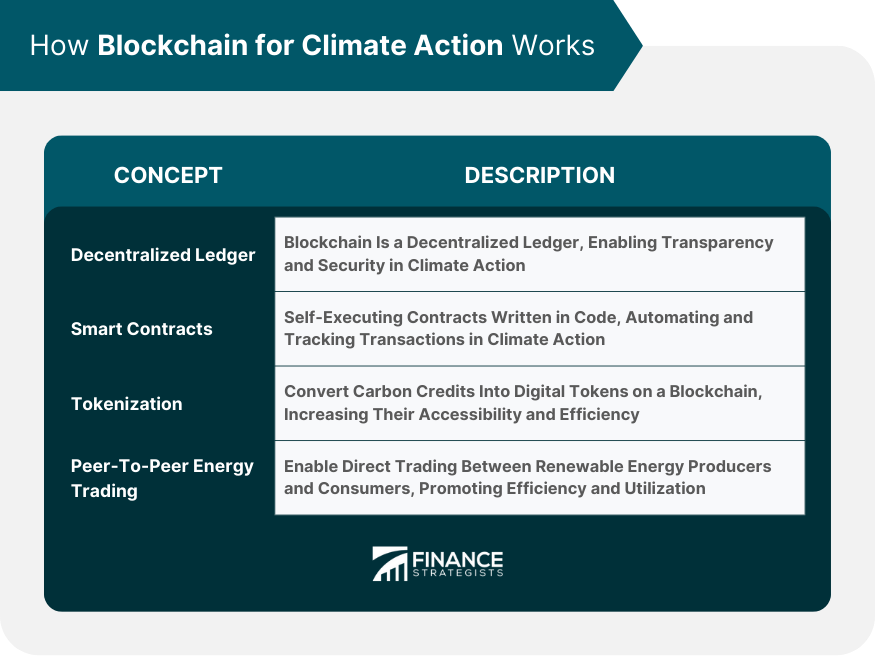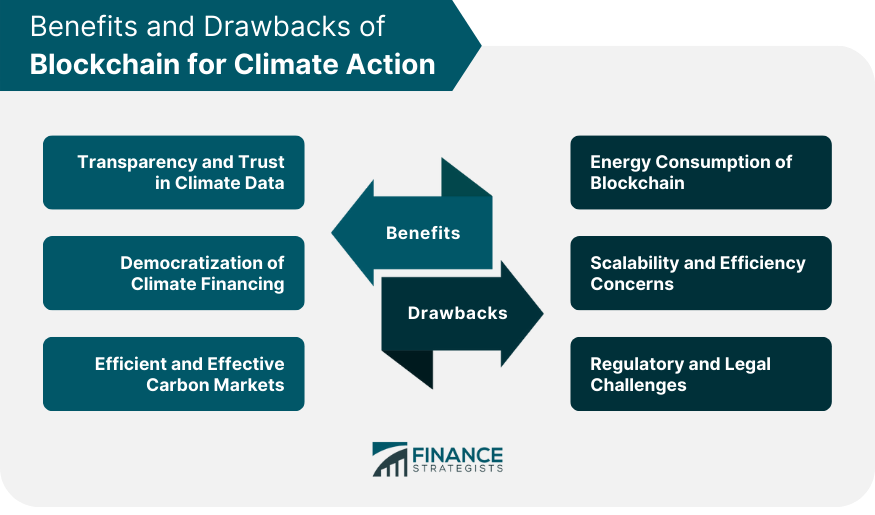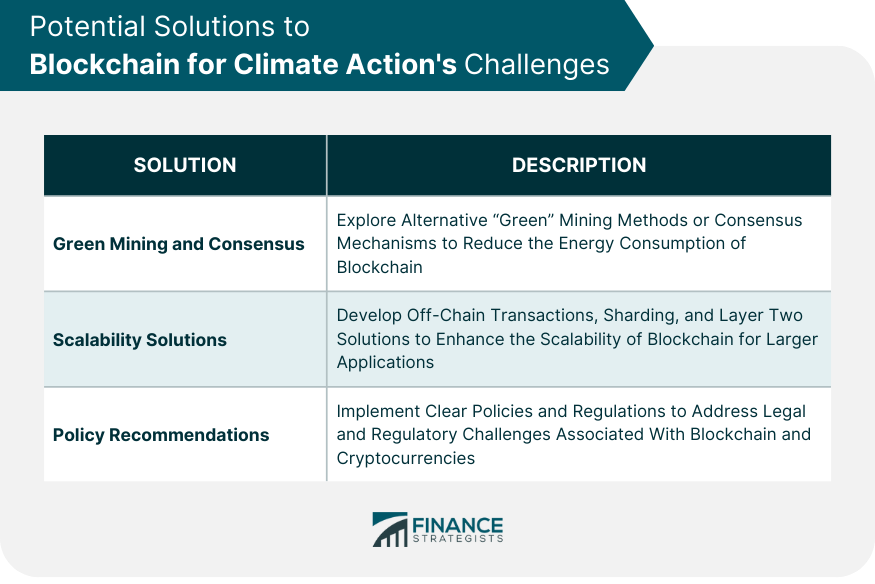Blockchain for climate action is a mechanism that uses decentralized digital ledger technology to track, verify, and secure transactions or data related to climate action. It includes applications such as carbon credit trading, decentralized renewable energy systems, climate finance, and data recording and verification. The primary purpose of blockchain for climate action is to instill transparency, efficiency, and trust in the processes related to climate action. The technology's potential to enable decentralized, transparent, and tamper-proof recording of data and transactions is critical for enhancing accountability in climate change mitigation efforts and climate finance. Understanding how blockchain technology facilitates climate action requires a look at its fundamental mechanisms and their applications. At its core, blockchain technology is a decentralized ledger. This means it allows for the recording of transactions or data across multiple devices on a network, thus eliminating the need for a central authority. This decentralization brings unprecedented transparency and security, enabling trust among participants. Smart contracts are self-executing contracts with terms of the agreement directly written into code. They facilitate automated, trustless transactions which are trackable and irreversible. In the context of climate action, smart contracts can be used to automate carbon credit trading or renewable energy trading. Tokenization is a process where assets are converted into digital tokens on a blockchain. In climate action, this can apply to carbon credits, turning them into tradeable digital assets. This can make the market for carbon credits more accessible and efficient. Blockchain can facilitate Peer-to-Peer (P2P) energy trading by allowing producers of renewable energy to trade directly with consumers. This can result in a more resilient and efficient energy system and promote renewable energy use. Beyond being a decentralized ledger technology, blockchain is also the underlying technology of cryptocurrencies. These digital currencies have significant potential to support climate action initiatives. Cryptocurrencies can be used to fund climate initiatives in various ways. For instance, blockchain projects can raise funds through Initial Coin Offerings (ICOs) or token sales. Moreover, climate projects or technologies can have associated tokens that individuals can buy to support these initiatives. The decentralization, transparency, and security features of blockchain technology make it a promising tool for carbon credit trading. By tokenizing carbon credits, they can be traded on a blockchain platform, improving the transparency and efficiency of the market. Blockchain technology's application in climate action offers several benefits that can enhance the efficiency and effectiveness of initiatives to mitigate climate change. Blockchain technology can record and verify climate data in a transparent and tamper-proof manner, fostering trust in this data. This can be vital for carbon credit markets, renewable energy trading, and other climate initiatives that rely on accurate and reliable data. Blockchain can democratize access to climate finance. By tokenizing assets like carbon credits or renewable energy, these markets can be made more accessible. Moreover, blockchain can enable peer-to-peer lending platforms for climate projects, opening up new avenues for climate finance. The transparency, security, and decentralization of blockchain can significantly enhance the efficiency and effectiveness of carbon markets. It can streamline transactions, reduce fraud, and improve market access, making these markets more efficient and effective. Despite its potential benefits, the application of blockchain in climate action is not without its challenges. One significant challenge is the high energy consumption of blockchain, particularly those using proof-of-work consensus mechanisms. This high energy usage, often associated with cryptocurrencies like Bitcoin, could offset the climate benefits offered by the technology. Another concern is scalability and efficiency. The current versions of public blockchains may not scale well as the number of transactions increases, potentially limiting their practicality for large-scale climate applications. The nascent state of blockchain technology and cryptocurrencies means that the regulatory and legal frameworks around them are still developing. This uncertainty could pose challenges to their use in climate action, where clear regulations and legal recognition are often necessary. Despite these challenges, solutions are being explored to leverage the benefits of blockchain for climate action while mitigating its drawbacks. To address the high energy consumption of blockchain, alternative "green" mining methods or consensus mechanisms are being explored. For instance, proof-of-stake or delegated proof-of-stake mechanisms can significantly reduce the energy consumption of blockchain. Various solutions are being developed to address scalability issues, including off-chain transactions, sharding, and layer two solutions. These technologies aim to enhance the transaction capacity of blockchain, making it more feasible for large-scale applications. Clear policies and regulations can address the legal and regulatory challenges associated with blockchain. Policymakers and regulators are working to create frameworks that recognize and regulate blockchain technology and cryptocurrencies while ensuring their safe and responsible use. The use of blockchain technology in climate action intersects with traditional finance in various ways. Impact investment, which seeks to generate social and environmental impact alongside a financial return, can benefit from blockchain. By providing a transparent and efficient platform for transaction and data verification, blockchain can enhance the credibility and appeal of impact investments in climate action. Blockchain can revolutionize how insurance and risk are managed in the context of climate change. It can automate insurance claims through smart contracts and provide a transparent and tamper-proof record of climate data, which can inform risk assessments. Public and Private Partnerships (PPPs) play a significant role in blockchain climate initiatives. Governments, NGOs, and private companies can collaborate on blockchain projects, leveraging their respective resources and expertise to achieve climate goals. Blockchain for climate action represents a compelling fusion of technology and environmental stewardship. By leveraging blockchain's distinctive attributes—decentralization, transparency, and security—there is potential for substantial advancements in climate change mitigation and adaptation strategies. This isn't to say challenges do not exist. High energy consumption, scalability issues, and regulatory uncertainties pose hurdles. However, with ongoing research and innovation, solutions are being pursued to overcome these challenges. Ultimately, the intersection of blockchain and climate action promises new possibilities for a sustainable future and deserves our collective attention and effort.What Is Blockchain for Climate Action?
How Blockchain for Climate Action Works
Decentralized Ledger Technology
Smart Contracts and Climate Action
Tokenization of Carbon Credits
Peer-To-Peer Energy Trading

Role of Cryptocurrency in Blockchain for Climate Action
Financing Climate Initiatives
Carbon Credit Trading
Benefits of Blockchain for Climate Action
Transparency and Trust in Climate Data
Democratization of Climate Financing
Efficient and Effective Carbon Markets
Drawbacks and Challenges of Blockchain for Climate Action
Energy Consumption of Blockchain
Scalability and Efficiency Concerns
Regulatory and Legal Challenges

Potential Solutions to Blockchain for Climate Action's Challenges
Green Mining and Consensus Mechanisms
Scalability Solutions
Policy Recommendations and Regulatory Measures

Intersection of Blockchain and Traditional Finance in Climate Action
Impact Investment and Blockchain
Insurance and Risk Management Using Blockchain
Public and Private Partnerships in Blockchain Climate Initiatives
Final Thoughts
Blockchain for Climate Action FAQs
Blockchain for Climate Action is the use of blockchain technology, a type of decentralized digital ledger, to facilitate efforts to combat climate change. It includes applications such as tracking and verifying climate data, carbon credit trading, decentralized renewable energy systems, and climate finance.
Blockchain for Climate Action works by applying the principles of blockchain technology to climate change mitigation efforts. This includes the use of decentralized ledgers for transparent data recording, smart contracts for automating transactions such as carbon credit trading, tokenization of assets like carbon credits, and peer-to-peer trading of renewable energy.
The benefits of Blockchain for Climate Action include increased transparency and trust in climate data, the democratization of climate financing, and more efficient and effective carbon markets. Its decentralization, transparency, and security features can enhance the efficiency and effectiveness of climate change initiatives.
Implementing Blockchain for Climate Action can be challenging due to the high energy consumption of blockchain technologies, scalability and efficiency concerns, and regulatory and legal uncertainties. However, solutions such as green mining methods, scalability technologies, and policy recommendations are being explored.
Blockchain for Climate Action intersects with traditional finance in several ways. It can enhance the credibility and appeal of impact investments in climate action, revolutionize insurance and risk management related to climate change, and facilitate public and private partnerships in climate initiatives.
True Tamplin is a published author, public speaker, CEO of UpDigital, and founder of Finance Strategists.
True is a Certified Educator in Personal Finance (CEPF®), author of The Handy Financial Ratios Guide, a member of the Society for Advancing Business Editing and Writing, contributes to his financial education site, Finance Strategists, and has spoken to various financial communities such as the CFA Institute, as well as university students like his Alma mater, Biola University, where he received a bachelor of science in business and data analytics.
To learn more about True, visit his personal website or view his author profiles on Amazon, Nasdaq and Forbes.











